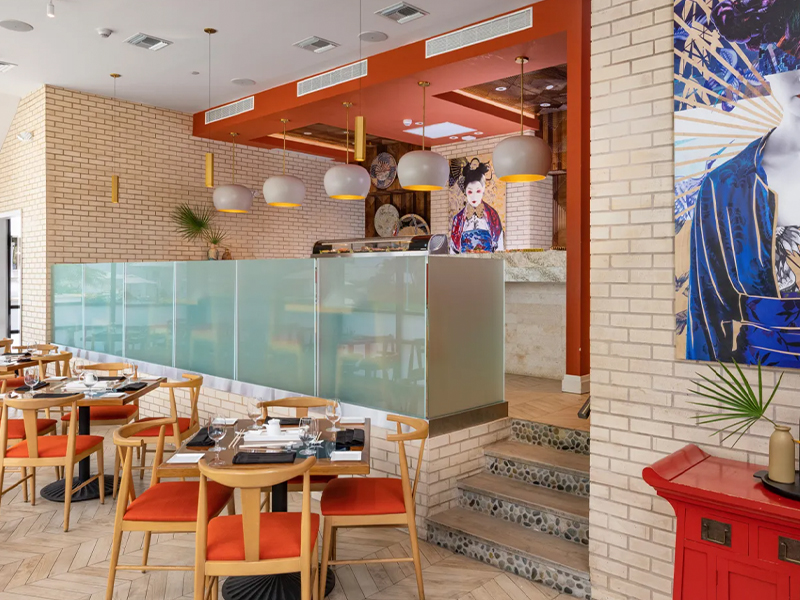In the world of interior design, art is more than decoration—it’s a powerful tool for creating harmony within a space. At LS Art Consulting, our art consulting company understands how art can transform interiors and influence the energy flow within a room, especially when guided by the principles of Feng Shui. With a focus on colors, elements, and placement, here’s how to use art to enhance a space’s balance and energy.
Understanding Colors in Feng Shui Art
Colors play a significant role in Feng Shui, each resonating with different elements and energies. The right choice of colors in your artwork portfolio can influence the mood and energy of a room, either enhancing or disrupting the desired balance.
Red, Orange, and Purple – Fire Element: These vibrant colors bring warmth, passion, and inspiration to a space. When used in art, they represent the fire element, invoking a sense of activity, excitement, and vitality. They’re ideal for spaces where you want to boost energy levels, such as living rooms or creative studios.
Green and Brown – Wood Element: Green symbolizes growth, health, and renewal, while brown represents stability and grounding. Art with these colors incorporates the wood element, which promotes new beginnings and personal growth. It’s especially effective in spaces meant for learning or healing, like offices or healthcare settings.
Yellow, Beige, and Light Brown – Earth Element: These colors foster stability, support, and nurturing energy. Art featuring earth tones can help create a comforting and secure atmosphere. It works well in places where people gather, like dining areas or communal spaces.
White, Gray, and Metallics – Metal Element: White and gray evoke clarity, precision, and focus. Metallic hues add a touch of luxury and sharpness. Art with metal elements is suitable for spaces where concentration and structure are valued, such as offices or study rooms.
Blue and Black – Water Element: Blue signifies tranquility, while black adds depth and mystery. Both embody the water element, bringing calmness and fluidity. Art with these colors is ideal for relaxation areas, such as bedrooms or meditation spaces.

Displaying Art with Feng Shui Elements in Mind
The five elements—wood, fire, earth, metal, and water—are central to Feng Shui principles, and using them to guide art selection and placement can help create a balanced space.
Wood Elements: Art that features natural materials like wood frames or botanical themes symbolizes growth and expansion. These pieces are perfect for spaces that require revitalizing energy or to balance overly “metallic” areas that feel cold or rigid.
Fire Elements: Incorporating artwork that has angular shapes, bold colors, or images of sunlight can bring the fire element into a room. Ideal placement would be in the southern part of a space, traditionally associated with fame and reputation in Feng Shui.
Earth Elements: Sculptures, pottery, and landscape paintings with earthy tones and textures can ground a room, offering a stabilizing effect. Display these pieces in the center or corners of a room to foster supportive energy.
Metal Elements: Metallic art pieces or monochrome paintings embody the metal element, which provides clarity and efficiency. These can be displayed in the western or northern parts of a room to enhance creativity or career-related energy.
Water Elements: Water-themed art, such as paintings of oceans or rivers, can introduce calm and adaptability to a space. To encourage a harmonious flow of energy, these pieces are best placed in the eastern or southeastern areas of a room.
Balancing Harmony and Avoiding Disruption
The relationship between art pieces and other objects in a room affects the overall energy. When selecting art or working with art consulting firms, consider the room’s layout, existing colors, and materials to create a harmonious environment.
Complementary Shapes and Materials: Use art that complements the shapes and materials already present. For instance, rounded objects or flowing patterns can soften spaces with harsh lines, while angular or bold pieces can add energy to overly soft rooms.
Proportion and Scale: Ensure the art fits the scale of the space. Large, bold pieces can dominate a room and energize it, whereas smaller pieces can bring subtlety and refinement.
Maintaining Energy Flow: Avoid overcrowding walls or placing art in areas that obstruct movement. Art should guide the flow of energy rather than interrupt it.
Reflecting the Environment on Artwork Selection
The environment where art will be displayed should also influence the choice of elements and colors. For example, in a tropical hotel, it’s essential to reflect the natural surroundings while maintaining balance.

Tropical Hotel Example: Given the abundance of natural elements, art should incorporate earth, water, and wood elements. Think of pieces that feature lush greenery, ocean scenes, or natural textures like bamboo. Avoid overwhelming the space with too much fire or metal energy, which could clash with the serene, natural surroundings.
Incorporating Feng Shui principles in art selection allows interior designers to craft spaces that not only look beautiful but also feel balanced and harmonious. By considering colors, elements, and placement, designers can enhance the energy flow within any space, creating a more inviting and functional environment. At LS Art Consulting, we guide you in choosing art that aligns with these principles, elevating the impact of your interior design projects.
Work together with our art consulting firm to transform spaces into sanctuaries of harmony and beauty through the art of Feng Shui. Contact us online today!


